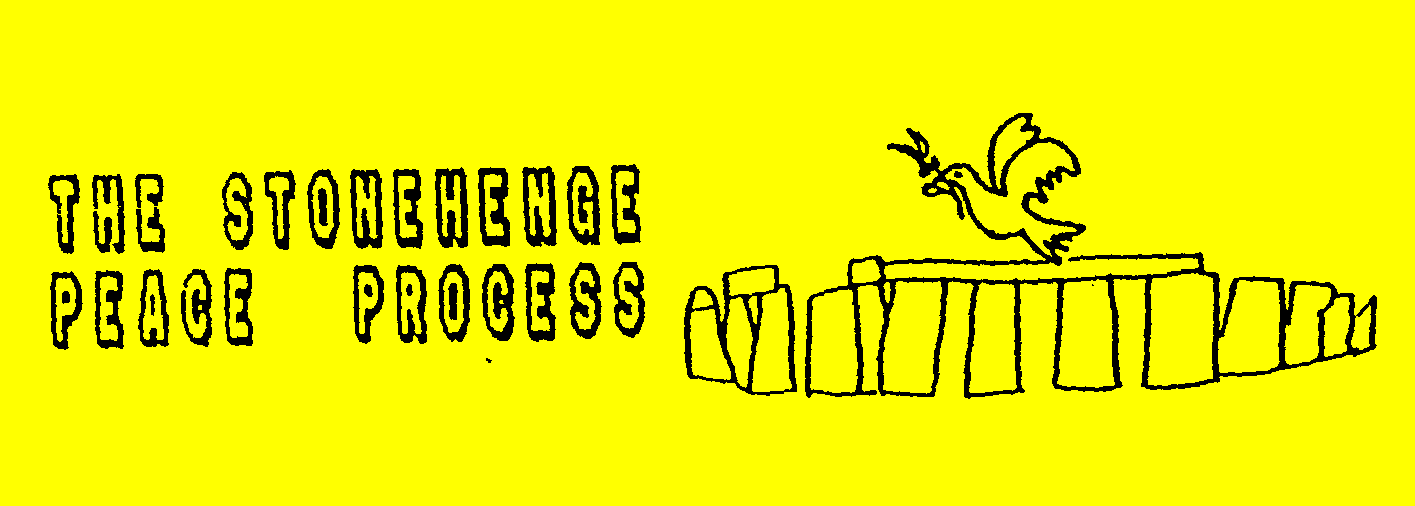
INTRODUCTION
Antiquarians in the 18th century connected it with the Druids and helped in a revival of druidry at that time, and it was also visited by local people, there was a large fair, and sports events in the area. During the century that has just passed, visits by druid groups and by members of the public focussed around the Summer Solstice in June. The Stonehenge Peoples' Free Festival founded by Wally Hope, took place near the stones, from about 1973 until 1984. In that last year it attracted from 30,000 to 50,000 people. There were complaints about some incidents, including burnt out stolen cars left on the site, and the open advertising and selling of illegal drugs. At the same time a whole community enjoyed and looked forward to the annual events.
On June 1st 1985 police of Wiltshire and Hampshire blocked and attacked a convoy of vehicles near Cholderton, arresting some 500 men women and children and destroying property. This, the so-called Battle of the Beanfield, was to prevent the Stonehenge Peoples Free Festival. But it has to be seen in the context of other extra-legal police actions in the Miners' Strike in 1984, at Broadwater Farm, and of inner city rioting during the 1980s. The government referred to "The Enemy Within" and presided over a deeply divided society.
In the years after 1985 Stonehenge was a focus for visits by pagans and druids interested in its ritual significance as well as protests by those who wished for a festival. Regular gatherings at the Winter Solstice and the equinoxes began. Every year Mid June was a time of stressful manouevre in which people tried to approach the area and Wiltshire Constabulary took what action they could to prevent them, there were large police actions in 1986 and 1988 and then the so-called exclusion zone was enforced from 1989 to 1998 when efforts were made to prevent anyone entering a four mile radius.
Over these years of troubles the people who stood on one side or the other took up polarised positions. If you were a landowner, or among those local politicians and residents who supported that side, including many in the media, Wiltshire was menanced by hippy invaders and unwashed travellers not to mention sinister political anarchists intent on theft, drug abuse, animal rights terrorism, and the general downfall of rural peace and civilisation. The story was exaggerated but focussed on some legitimate fears and concerns.
From the other side the desperate measures used by the police, the propaganda in the press, were seen as sinister reactionary assaults on the liberty of the individual and against alternative culture. The festival with its upside of joy, music and youthful experiment was banned, religious rights overruled, fundamental freedoms to travel in one's own country, to peaceful assembly, to protest and to enjoy life were being snuffed out. It was a dark night of the extreme right and people were willing to stand up against the illegalities, the cover-ups, the bans and the language of discrimination, which transformed British visitors to Wiltshire into sinister "invaders" who were said to be "pouring" in, this resembled the language of racism. The story was exaggerated but focussed on some legitimate concerns.
In order to solve the problems caused by these years of troubles it is necessary for everybody involved, to talk about what has happened, and especially for those on the two sides of the divide, to meet each other as human beings, and negotiate solutions, and understand the historical perspectives sketched out here, and restore the unity of society that was broken. This is what The Stonehenge Peace Process is about. Obviously this, if it is successful, is a process that goes beyond Stonehenge, towards the healing of the British nation.
There was an exclusion zone in 1998 with people chased through the fields by police, but at the same time special parties in buses attended the dawn and Solstice Eve for the first time in ten years. In 1999 there was no exclusion zone, but carefully laid plans for special parties were disrupted by an apparently spontaneous occupation of the stones. Moving forward is a difficult process for everyone, but the talking, both officially, through a round table invited by English Heritage, the managers, and through the efforts of The Stonehenge Peace Process, continue. And have borne fruit with the successful initiative to open the stones throughout the night and in the early morning, in 2000 and 2001, which we expect to continue in 2002.
Click on to Main Stonehenge menu
Click on to History of the Troubles The Stonehenge Archives
Click on to Summer Solstice 2001 What happened.
Click on to Peace Stewards Volunteer to be an independent responsible person with the SPP!
Click on to Links Page Links to other Stonehenge sites and organisations
You may subscribe to our newsgroup below: